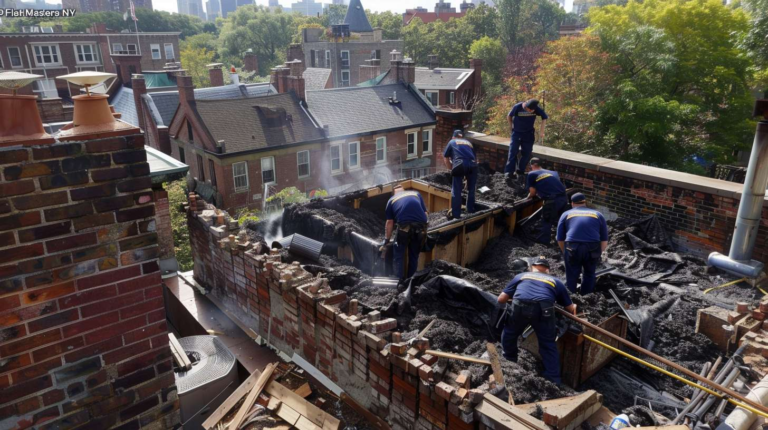Understanding Flat Roof Drainage System Details for Your Property
Look, I've been installing and repairing flat roof drainage systems across Queens for over two decades now, and I can tell you that proper drainage is absolutely critical to your roof's longevity. Last month alone, we responded to three emergency calls in Astoria where homeowners ignored their drainage issues until water started pooling and eventually leaked through their ceiling. Don't be that person.
The thing about flat roof drainage system details is that they're not as straightforward as pitched roofs where gravity does most of the work. Your flat roof needs a carefully engineered system to move water off efficiently, and every component has to work perfectly together.
Interior Drainage Systems: The Heart of Your Flat Roof
When we talk about interior drainage flat roof detail, we're looking at the most common system in Queens commercial and residential buildings. These systems use roof drains positioned at low points on your roof, typically at least one drain per 1,000 square feet of roof area - though I usually recommend more based on our heavy rainfall patterns here.
The interior system starts with the roof membrane sloping toward drain locations at a minimum 1/4 inch per foot. Here's where most contractors cut corners: they don't create proper crickets and saddles around the drains. A cricket is that triangular structure that diverts water toward the drain, preventing it from sitting around the drain opening.
I remember this job we did on Queens Boulevard three years ago - the previous contractor had installed drains without proper tapers, and water was actually pooling around the drain instead of flowing into it. We had to rebuild the entire drainage pattern using rigid insulation to create the proper slopes.
Roof Drain Details That Actually Matter
Flat roof roof drain detail involves several critical components that work together. The drain itself consists of a drain body, usually cast iron or PVC, with a flange that sits under your roof membrane. The membrane is adhered directly to this flange - no gaps, no shortcuts.
The drain dome or strainer sits on top, keeping debris out while allowing water to flow freely. And here's something most property owners don't realize: that dome needs to be cleaned regularly. I've seen $50,000 in water damage from a clogged drain that could have been prevented with a $5 cleaning.
Underneath, the drain connects to your building's internal plumbing system through a leader line - that's the vertical pipe that carries water down through your building. The connection between drain and leader needs to be watertight and properly supported. We use mechanical joints with rubber gaskets, never just pipe cement.
Comprehensive Flat Roof Drainage Details
When I'm explaining flat roof drainage detail to customers, I break it down into three main systems: interior drains, scuppers, and gutters. Most buildings in Queens use a combination of these for redundancy.
Your primary drainage handles normal rainfall - that's usually your interior drains. Secondary drainage kicks in when primary drains are overwhelmed or blocked. This is where scuppers come in, acting as overflow protection.
The roof deck itself needs proper slope toward your drainage points. We achieve this through structural sloping, tapered insulation systems, or a combination of both. I prefer tapered insulation because it's more cost-effective for retrofit situations, which is most of what we see in Queens.
Oh, and another thing about drainage design - you need to consider snow load and ice damming. Our winters can be brutal, and ice formation around drains can completely block your drainage system. That's why we install drain heaters on critical roofs.
Scupper Systems: Your Overflow Protection
Flat roof scupper detail is something I wish more contractors understood properly. A scupper is basically a drain through your parapet wall that allows water to flow off your roof when primary drains can't handle the volume.
The scupper opening needs to be properly sized - typically 4 inches by 5 inches minimum for most applications. The bottom of the scupper should sit about 2 inches above your roof surface to prevent normal drainage from flowing through it, but low enough to provide emergency overflow.
Here's where it gets tricky: the scupper throat needs to be lined with the same membrane system as your roof, and that lining has to extend up the wall and over the outer edge. Most leaks I see around scuppers happen because this flashing detail wasn't done right.
We typically install a conductor head or leader box below the scupper to catch the water and direct it into downspouts. Without this, water just cascades down your building wall, causing staining and potential structural issues.
Technical Considerations for Queens Weather
Living near the water here in Queens means we deal with serious weather. Hurricane Sandy taught us a lot about drainage capacity - many buildings that had adequate drainage for normal conditions were completely overwhelmed by that storm surge and rainfall.
I now calculate drainage systems for a 100-year storm event, not the standard 25-year event. That means more drains, larger pipes, and redundant overflow systems. It costs more upfront but saves you from catastrophic failure later.
The salt air from the East River and Long Island Sound also affects our material choices. We use stainless steel hardware around all drain assemblies and apply additional coatings to protect metal components from corrosion.
Common Drainage Problems I See Every Week
Blocked drains are the number one issue. Leaves, debris, even tennis balls from nearby courts - I've pulled everything out of roof drains. That's why I always recommend installing larger drain domes with finer screening.
Ponding water is another major problem, usually caused by inadequate slope or settled roof decking. If water sits on your roof for more than 48 hours after rainfall, you have a drainage problem that needs addressing.
Improper flashing around drain penetrations causes more leaks than any other roofing issue. The membrane has to be properly adhered to the drain flange with no air bubbles or gaps. We use primer, adhesive, and mechanical fasteners for a triple-redundant connection.
Maintenance That Prevents Emergency Calls
Look, I can't tell you how many emergency calls we get that could have been prevented with basic maintenance. Clean your drains quarterly - more often if you have trees nearby. Check your scuppers after every major storm to make sure they're clear.
Inspect the membrane around all drain assemblies annually. Look for cracking, separation, or bubbling. Small problems become big problems fast with drainage systems.
And here's something most people miss: check your leader lines inside the building. A blocked or broken pipe inside your wall can cause just as much damage as a roof leak, but it's harder to detect until water starts showing up where it shouldn't.
At Flat Masters NY, we offer comprehensive drainage system inspections and maintenance programs because proper drainage is that important to your roof's performance. Whether you need a complete system design for new construction or emergency repairs after a storm, we've got the experience and local knowledge to get it done right. Give us a call at (917) 994-7618 - we're here to help keep your Queens property dry.


